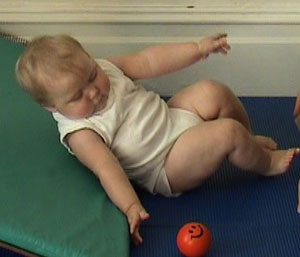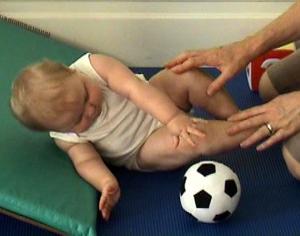Over the first 6-8 months infants acquire the strength, flexibility and coordination to sit with good balance and reach in all directions.
On this page I have provided some ideas for how you can help your infant gain the strength and coordination needed for sitting with good balance.
Sitting on a carer's lap is a good place to start
An infant's first sitting experience is usually sitting on a carer's lap. This experience gives the infant a chance to practice keeping the head upright and steady, as well as an opportunity to turn to head to look at interesting things and people.
Active infants will look around and reach out in different directions. They also make use of all the available surfaces for support as they lean in different directions.
Provide your infant with many opportunities to sit on your lap. Hold him/her with just enough support to keep him/her safe and encourage reaching for toys to get active trunk work.
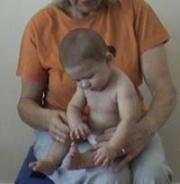

Next work on sitting balance
Active infants start to sit independently at between 8-10 months. The infant's first task is to learn to balance in sitting. This takes lots of practice and sitting between two raised cushions is a good way to start.
Use toys to encourage your infant to reach in different directions, and then come upright again.


Now it is time to get active in sitting
Active infants who have leaned to sit independently quickly become very active in sitting. They pick things up, reach and twist and start coming up onto their hands and knees. All this sitting action is important for strength, balance and coordination.
Cautious infants are often very inactive in sitting. When they want something they make a fuss until someone puts it in easy reaching distance.
Sitting games are a good way to get your infant more active in sitting.
Getting from sitting onto hands and knees
Active infants easily move from sitting onto hands and knees. This action requires good trunk and arm muscle strength.
Your infant may find it easier to move from sitting to kneeling at a low step.


Sitting on a low step to get ready for standing up
Stretching the hip muscles
Many children with developmental delay have some tightness in the hip muscles which affects their ability to move from sitting into the crawling position as well as getting up into standing. Regular, gentle stretching helps to overcome this problem.

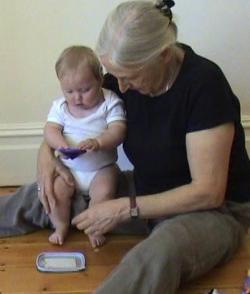
Bouncing and tipping games for strength and stability

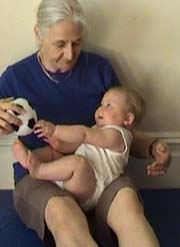
Sitting up from a slope
Sitting up from a slope is easier than sitting up from lying flat on the floor. This activity trains the infant to lift her head when she is on her back and to twist and push on her arms to come up into sitting. This activity is also good for strengthening the neck and tummy muscles.
